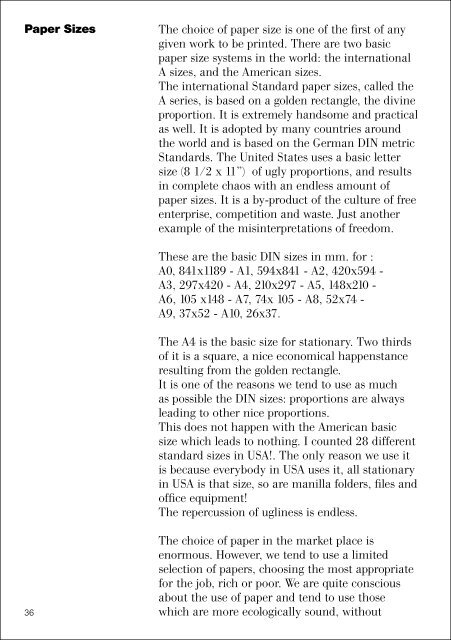You also want an ePaper? Increase the reach of your titles
YUMPU automatically turns print PDFs into web optimized ePapers that Google loves.
Paper Sizes<br />
36<br />
The choice of paper size is one of the first of any<br />
given work to be printed. There are two basic<br />
paper size systems in the world: the international<br />
A sizes, and the American sizes.<br />
The international Standard paper sizes, called the<br />
A series, is based on a golden rectangle, the divine<br />
proportion. It is extremely handsome and practical<br />
as well. It is adopted by many countries around<br />
the world and is based on the German DIN metric<br />
Standards. The United States uses a basic letter<br />
size (8 1/2 x 11”) of ugly proportions, and results<br />
in complete chaos with an endless amount of<br />
paper sizes. It is a by-product of the culture of free<br />
enterprise, competition and waste. Just another<br />
example of the misinterpretations of freedom.<br />
These are the basic DIN sizes in mm. for :<br />
A0, 841x1189 - A1, 594x841 - A2, 420x594 -<br />
A3, 297x420 - A4, 210x297 - A5, 148x210 -<br />
A6, 105 x148 - A7, 74x 105 - A8, 52x74 -<br />
A9, 37x52 - A10, 26x37.<br />
The A4 is the basic size for stationary. Two thirds<br />
of it is a square, a nice economical happenstance<br />
resulting from the golden rectangle.<br />
It is one of the reasons we tend to use as much<br />
as possible the DIN sizes: proportions are always<br />
leading to other nice proportions.<br />
This does not happen with the American basic<br />
size which leads to nothing. I counted 28 different<br />
standard sizes in USA!. The only reason we use it<br />
is because everybody in USA uses it, all stationary<br />
in USA is that size, so are manilla folders, files and<br />
office equipment!<br />
The repercussion of ugliness is endless.<br />
The choice of paper in the market place is<br />
enormous. However, we tend to use a limited<br />
selection of papers, choosing the most appropriate<br />
for the job, rich or poor. We are quite conscious<br />
about the use of paper and tend to use those<br />
which are more ecologically sound, without<br />
compromising the end result.<br />
For stationary we like to use a heavy paper (100%<br />
cotton - sub 28) for executive level, and a regular<br />
bond for business level. Same paper for the<br />
envelopes, usually with a square flap. Size may<br />
vary according to countries.<br />
For books, it depends very much on the kind of<br />
book. For text books, we use a book paper; for<br />
illustrated books we will use a coated, dull or<br />
glossy according to the subject, although we tend<br />
to prefer dull papers. The quality of reproduction<br />
continues to improve, better papers, better inks,<br />
better printing presses, better technologies.<br />
The field is in continuos motion and we have to<br />
keep up with the times. Every technology implies<br />
different production costs and we should be aware<br />
and work with the suppliers to optimize costs and<br />
quality. Not all the countries share the same level<br />
of printing quality and we have to try to obtain the<br />
best in every situation.<br />
Not all papers are available around the world and<br />
that sometime poses some quality problems.<br />
Whenever possible, we like to use both sides of a<br />
sheet of paper, even when we do posters, offering<br />
the possibility of increasing and pacing the<br />
information on a large piece of paper, rather than<br />
wasting one side.<br />
The most common poster sizes in Europe are:<br />
50x70, 70x100, 100x140 centimeters.<br />
More poster sizes are available in the USA.<br />
In designing a book, a brochure, or any other<br />
kind of printed matter, the choice of the paper size<br />
involves quite a complexity of issues. Sometimes<br />
it has to conform to previous related publications,<br />
sometimes it has to break a new ground,<br />
sometimes the size itself becomes the carrier of a<br />
message even before anything is printed on it.<br />
The choice of a size is a very important decision.<br />
It involves costs and is part of the overall economy<br />
of the production process. It is important that


